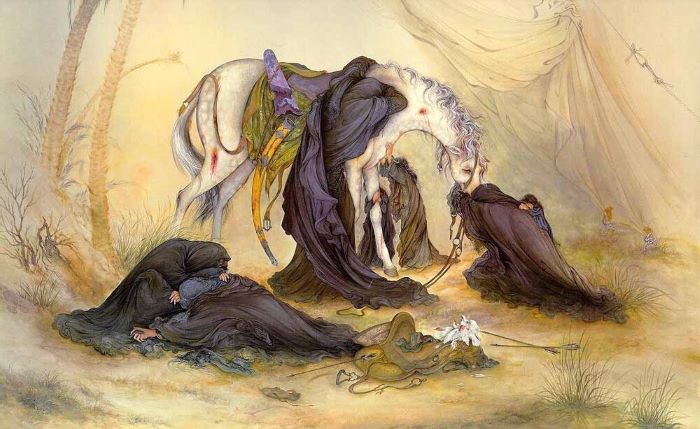Tents of Muharram
You are Here: Tweet, Like, Share, Comment, Subscribe…be the Voice of Free Press!
By Shahana Naqvi, Edited By Adam Rizvi, The India Observer, TIO: The Evening of Ashura, made by Persian artist Mahmoud Farshchian in 1976, is considered a masterpiece depicting the tragedy of the day of Ashura. The painting captures the grief and deep mourning of the helpless household of Imam Hussain when the horse returns to the tents without its rider, Imam Hussain (AS), from the battlefield of Karbala.
The artist donated this artwork to Astana-e-Quds Museum in the holy shrine of Imam Reza (AS) in 1990, along with his 12 paintings on the tragedy of Karbala.
Introduction:
The tragedy of Karbala, when narrated through Soz (lamentations), Salaam (a common greeting in Arabia), Sermons (lectures), Marsiya (elegies), Dirges (laments for the dead), and Nauha (poetic laments often in Urdu and Persian), evokes a landscape of dry hot desert land, palm trees, tents, and the family and companions traveling with Imam Hussain, leading up to the subsequent burning of tents on the day of Ashura.
Tent
A tent is a shelter consisting of sheets of fabric or other materials draped over or attached to a frame of poles or a support rope. Tents are used as habitation by nomads, recreational campers, soldiers, and disaster victims. They are also used for weddings, parties, festivals, corporate events, excavations, and military campaigns.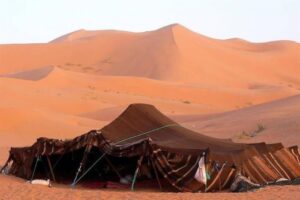
Tents have been used by nomadic people all over the world — in Native America, Mongolia, Turkic regions, Tibetan nomads, and Bedouin tribes.
Tents in Karbala
The portable dwelling tents, also known as Khemiyya in Arabic, played a crucial role in providing shelter to Imam Hussain’s family along the treacherous route through the hot desert landscape of Arabia when he, along with his family, moved away from Medina (now Saudi Arabia) to avoid getting murdered in the holy sanctuary of Kaaba. Yazid had sent men to kill him during the Hajj pilgrimage.
Yazid’s Governor, Obaidullah ibn Ziyad, prevented Imam Hussain’s caravan from reaching Kufa (upon the invitation of the people of Kufa), forcing them to divert towards Karbala where Imam Hussain was surrounded by Yazid’s army. Upon reaching Karbala, he ordered his tents to be pitched near the Euphrates River.
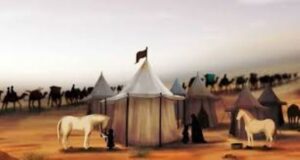 The tents were arranged in a horseshoe shape to provide better protection. A trench was dug behind the tents to prevent attacks from that side. The first tent belonged to Imam Hussain, which was the largest, where meetings were held to prevent bloodshed. Hazrat Abbas pitched his tent nearby to protect his beloved brother and family.
The tents were arranged in a horseshoe shape to provide better protection. A trench was dug behind the tents to prevent attacks from that side. The first tent belonged to Imam Hussain, which was the largest, where meetings were held to prevent bloodshed. Hazrat Abbas pitched his tent nearby to protect his beloved brother and family.
Women’s tents were set up on the western side of Imam Hussain’s tent, with Bibi Zainab’s tent just behind his. Around 60 tents, spaced 2 meters apart, were dug and arranged closely together. The Banu Hashim ensured their tents were near those of the women and children to protect them from the enemy’s brutality.
Painting of Karbala Battlefield
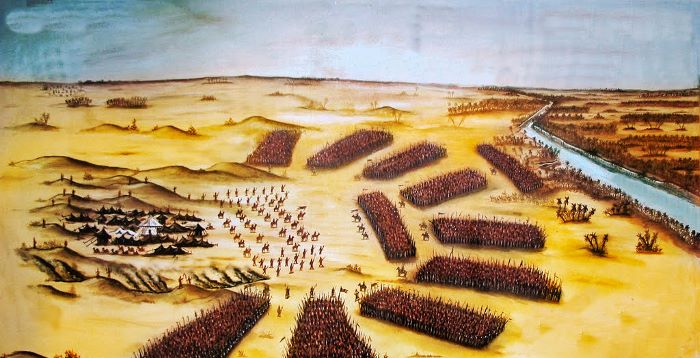
Evening of Ashura
After the brutal martyrdom of Imam Hussain and his companions on the day of Ashura (10th Muharram), the enemy sought to plunder and burn the tents of the holy family. The army invaded the tents, looting horses, camels, furniture, clothes, and even the jewelry of the women. They didn’t spare the earrings of Bibi Sakina (Imam Hussain’s favorite four-year-old daughter), leaving her crying in trauma and pain after losing her father in one of the most inhuman acts of aggression.
“Our tents were set on fire,” (Hadith attributed to Imam Reza AS).
According to historical records, all the tents of Imam Hussain’s family were burned, including the last one where Imam Sajjad (AS) (the fourth Imam and the only surviving son of Imam Hussain at the time) lay ill and where the women were gathered.
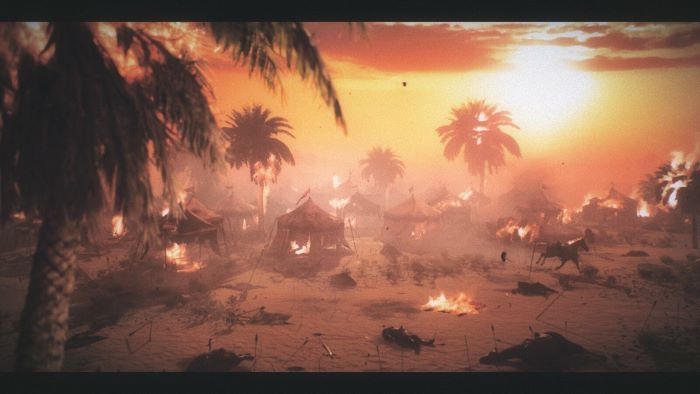
In Remembrance of the Tragedy
This hadith attributed to the Holy Prophet (PBUH) implies that believers will always carry pain in their hearts over the unjust murder of Imam Hussain and his companions at Karbala. Over 1400 years have passed, yet the tragedy of Karbala continues to be commemorated worldwide in various ways — through lamentations, plays (taziyeh), elegies, walking on fire, burning of tents, and chest-beating — not only by Muslims, particularly Shias, but by people of other faiths and religions as well.
The Hussaini Camp (Al-Mukhayyam al-Hussaini)
Al-Mukhayyam, meaning the tent ground or encampment in Karbala, Iraq, commemorates the location where Imam Hussain and his companions camped during the Battle of Karbala. Kheymehgah in Persian, it symbolizes the place where the tents of Imam Hussain and his family were pitched. Spread across approximately 5 km, it is located about 400 meters from Imam Hussain’s shrine.
Sound historical research suggests that the encampment was arranged in a vast horseshoe or crescent shape. This replica holds immense symbolic value, linking the suffering of the Prophet’s family during the Battle of Karbala.
Al Mukhayyam site is mentioned in a travel book of German tourist 1765-6, who entered Iraq and visited Karbala, that time it was located on the suburbs of Karbala towards Kufa.
Al-Mukhayyam al-Hussaini Now
The building of Al Mukhayyam or tenting ground is located in the south western side of Holyshrine of Imam Hussain AS in Karbala.
During Saddam Hussain’s rule, Karbala and its surrounding areas were badly damaged. Ashura and Arbaeen processions were banned. After his fall, reconstruction of the holy sites resumed in full swing.
The building
The Al Mukhayyam al Hussaini building features 16 arches in pristine white marble resembling palanquins, symbolizing the transport of the Karbala martyrs’ families to Kufa. A large blue/green dome stands above the encampment area. Key spots include the location of the tents, Hazrat Ali Asghar’s cradle, Bibi Zainab’s hujra, the place of Imam Hussain’s final prostration (sujood), and the place of Zuljanah, the horse.
Recently, Zarih structures have been installed to mark these spots. The Zarih at Hazrat Abbas’s tent is the first one seen upon entering Khemeygah.
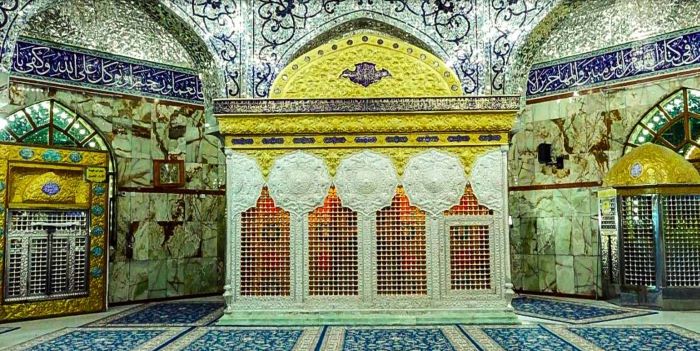
The Khemeygah is not just a historical site but also an emotional and spiritual one that reinforces the collective memory of Ashura.
Terrorist Attack
On March 17, 2008, a female suicide bomber exploded herself at Al-Mukhayyam al-Hussaini, killing 43 people and injuring 73 others.
Burning of Tents (Al-Tashabiyya wa Harq al-Khiyam)
This mourning ritual, held during Muharram in Iraq and Iran, is observed as a reminder of the burning of Imam Hussain’s tents and the harassment of his family. In India, people express their grief by walking barefoot on burning coals.
This ceremony is described as one of the oldest mourning ceremonies of Shiites which dates back to Buyid dynasty (934-1056). In this ceremony,
green, black and white tents are erected from first day of Muharram and of symbolically set fire on tenth day of Muharram or Ashura, (they set fire at noon or in the afternoon) This ritual is held as a reminder of the burningof Imam Hussain’ tent and the unjust harrassement of the pure ladies of his family after hiss martyrdom on the day of Ashura.
This ceremony dates back to the Buyid dynasty (934-1056) and is symbolically performed by setting fire to green, black, and white tents on Ashura. Despite being banned during Reza Shah Pahlavi’s reign, it continued secretly.
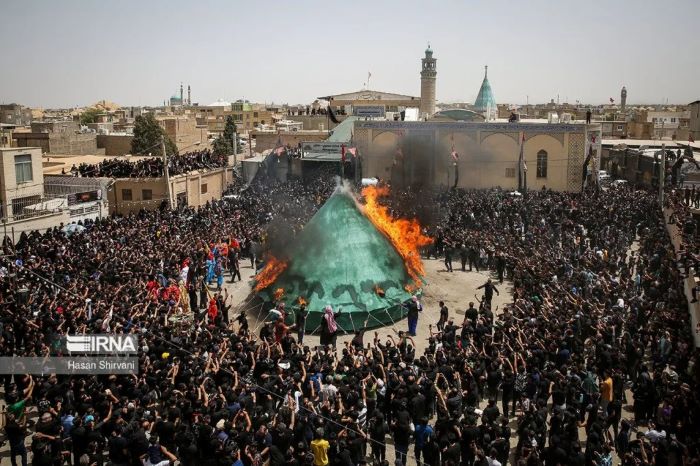
Iraq
The tent burning ceremony has been held in cities like Najaf, Karbala, and Baghdad since the 19th century. Rituals are observed in various locations like Nasiriyah, Baghdad, Basra, with participants often dressed in historical costumes.

India-Aag Ka Maatam
Shiites in India and South Asia light fires in pits in Imambada’s and walk on them barefoot to mourn burning of Imam Hussain’s tents .The act of walking on fire is not intended as self harm but powerful expression of sorrow and grief of the people that connects them to the suffering at Karbala.
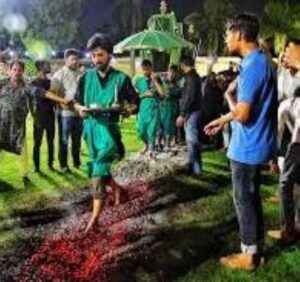
The burning of tents and walking on burning coals serve as a remembrance to the injustice and oppression faced by Imam Hussain and his family, it helps connect the believers with their pain and in solidarity with them.
Flames of faith (Mashal Gardani)
Mashal Gardani, or rolling of torches, is a deeply rooted ritual event in Iraq and Iran, performed on the nights of Tasua and Ashura. Large torches made of wooden poles with woolen cloths
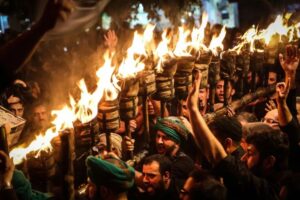
soaked in oil or diesel are carried by strong individuals. Chanting of elegies and chest-beating accompanies the procession. This ritual reflects regret for not aiding Imam Hussain and his family during Karbala.
Mashaal vary in shape and size and require significant physical strength to carry. Strong and tall individuals from the mourning groups bear the heavy torches on their shoulders, accompanied by others who help ensure the torch does not fall or cause harm. While carrying the torch or mashaal, men chant melancholic and mournful couplets known as nohe and elegies while beating their chests.
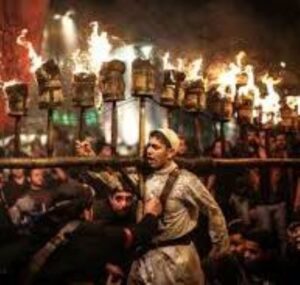
This ritual is designed to express a deep sense of regret to believers for not coming to Imam Hussain’s aid during the time when the honorable ladies of his household were harassed by the evil forces, who burned their tents in the wake of his martyrdom.
It invites believers to witness the power of ritual and remembrance, where light and sound converge to honor the memory of Imam Hussain and his companions against the backdrop of the night sky and swirling flames.
In Iran—Qom, Tehran, Shahr-e Rey, Ardakan, Yazd—while in Iraq—Najaf, Karbala, Baghdad—are places where this ritual is observed during Muharram.
Observing Muharram in Tents — India
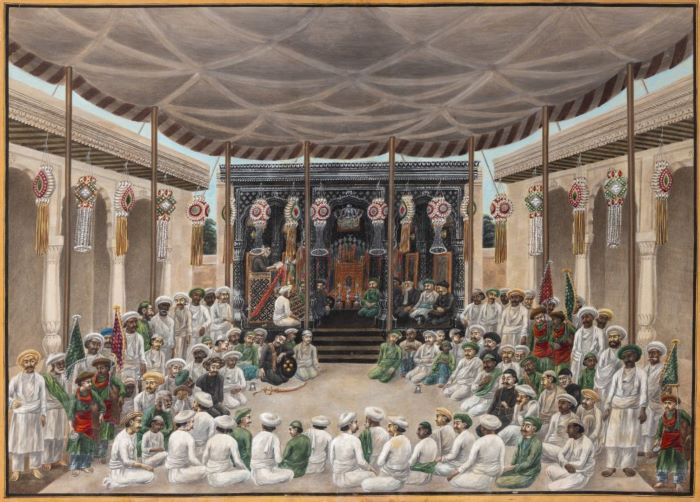
Company paintings from the 19th century depict Majlis gatherings under tents, which have now mostly been replaced by Imambaras.
The above painting shows a Majlis gathering during Muharram, with a person delivering a sermon from the pulpit and the public listening to him while sitting under the shade of a tent, which has been kept in place with slender wooden poles. Over time, such gatherings in India have been lost with the construction of Imambaras or buildings, and various other ways of mourning during Muharram.
Lucknow — Khaimah Gah
Built in memory of the encampment site in Karbala, the Khaimah Gah is located in Karbala Malika Jahan (Aishbagh), Lucknow. It is used for delivering sermons and rituals associated with the burial of Tazias on Ashura and Arbaeen.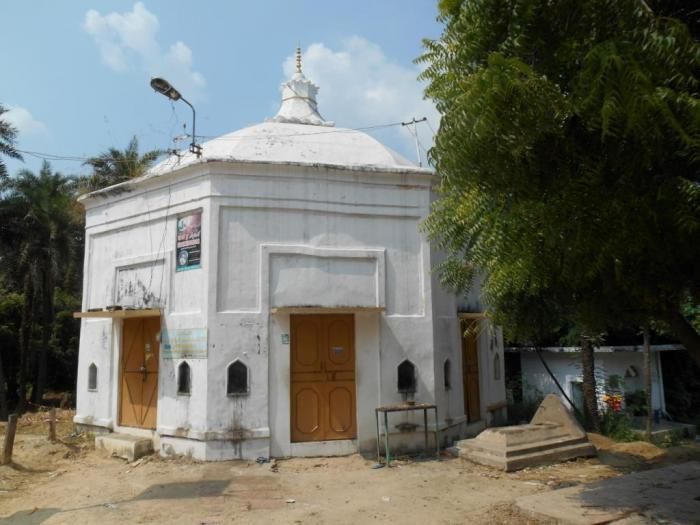
Iran — Hussainiyas and Mourning Tents
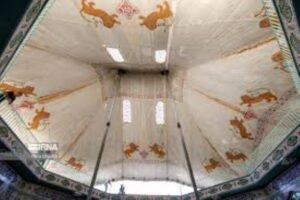
Hussainiyas in Iran were built by nobles to accommodate large gatherings for Muharram rituals. Temporary roofs (tents) were erected in their courtyards, adorned with Persian motifs like the lion and sun, cypress trees, and elegies written in honor of the Karbala martyrs.
Usually, Hussainiyas were built by rich and influential people of each city. For this, many residences of nobles and princes were constructed in such a way that, by installing a temporary roof or a large tent, a covered space could be created, making it possible for people to gather in large numbers and perform ta’ziya (a passion play designed to mourn the tragedy of Karbala). Hussainiyas were built in crowded areas, enabling people to access them easily.

The courtyard of Hussaniya is called Abbasiya because the ceremony related to the battles between Hazrat Abbas AS and Imam Hussain AS with their enemies is held here.

Motifs
The temporary roof of a tent is erected in this middle space. These tents are designed with various motifs such as two lions, the sun and lion (Qajar symbol), the cypress tree or tree of life motif. It is painted with exquisite Persian couplets written in honour of the martyrs of Karbala.
Iraq — Faziliyya Tent at Hazrat Abbas’s Shrine
Every year, before Muharram, a mourning tent is installed within the shrine of Hazrat Abbas, named the Faziliyya Tent, with a 250-year-old history.
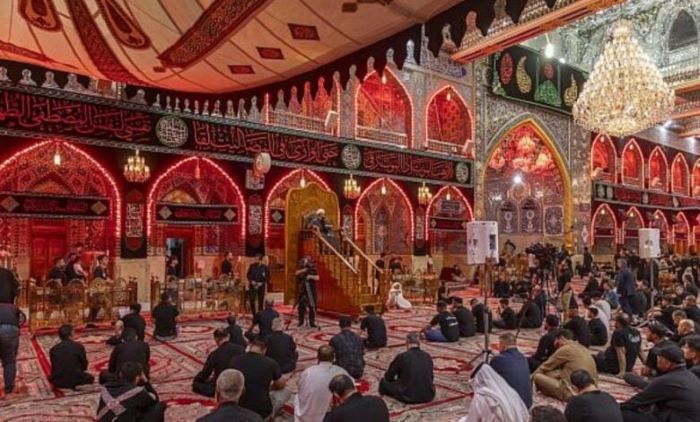
Glass tents
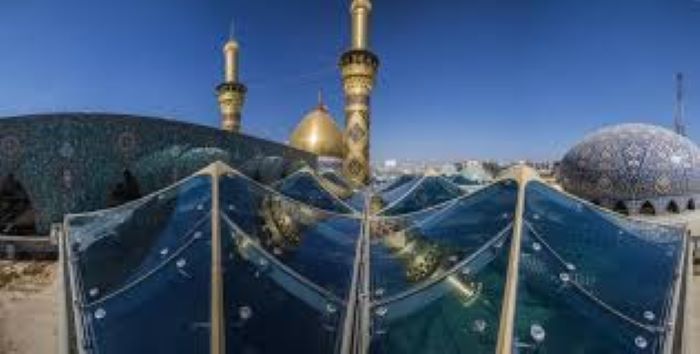
Hazrat Abbas shrine has a design philosophy that chooses to honour the life and sacrifice of Hazrat Abbas , 34 glass tents have been recently been installed as each of them represents the tents of children whose protector was Abal Fazl al Abbas.
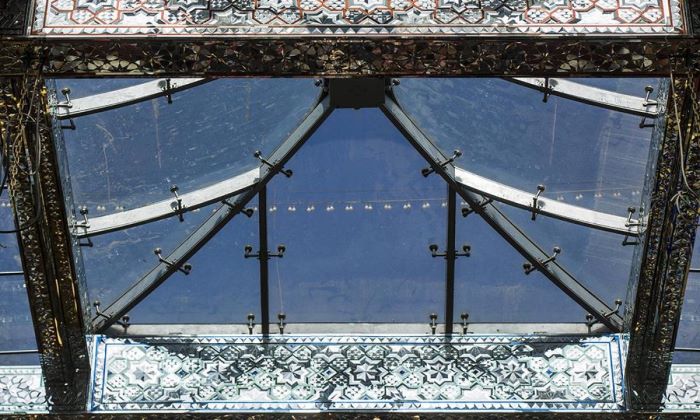
The new glass ceiling of the holy sanctuary has a transparent view of the space by 40 % these Sky lights saves electricity consumption during the day and also maintains the architectural design even after covering it.
Taziyeh Performances
Muharram, the month of mourning especially the days leading to Ashura (10th Muharram) many grounds in Iraq and Iran are occupied with Taziyeh performance of accompanied by sound of drums and melancholic lamentations.
Tents are central to taziyeh performances — passion plays that narrate the tragedy of Karbala in Iran and Iraq during Muharram.
Exhibitions
In a way to keep the message alive, featuring first of it’s kind , Imam Hussain (AS) Legacy Exhibition on Edgware Road , London utilised several forms of media, art and creativity to bring unrivalled representation of the tragedy of Karbala inOctober 2014.

Tent of Art (Kheimeh Honar)
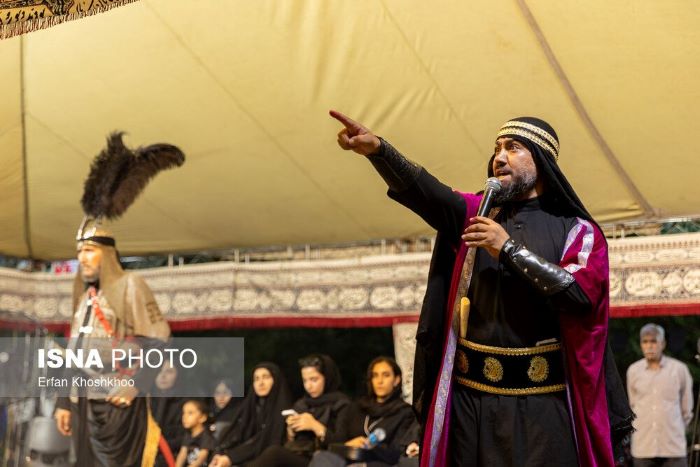
The Iranian Ministry of Cultural and Islamic Guidance’s Artistic Affairs Department inaugurated Kheimeh Honar (Tent of Art) at Rudaki Open Air Theatre, Tehran, in June 2025. The event features taziyeh performances, elegies, exhibitions, and lamentations centered on Karbala.
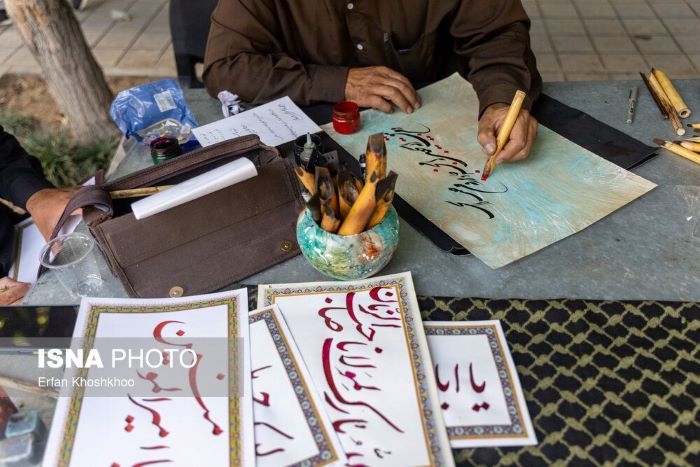
The event seeks to honour the sacred month of Muharram and the martyrdom of Imam HussainAS and aims to unite artists from diverse disciplines to pay tribute through creative expression ,to serve as a vibrant platform of creative expression, spiritualreflection and community engagement.
Many events like Taziyeh performance, elegies and dirges, several thematic exhibitions, rituals of lamentations, Ashura themed sacred lamentations are planned centred around the remembrance of Karbala.

Conclusion
Ayatollah Syed Ali Khamenei, in a statement on March 12, 2002, said: “During 50 to 60 years after the Prophet’s (PBUH) passing, Islam had changed so much that in the Islamic world, those dear to the Prophet were openly killed and taken captive. Imam Hussain (PBUH) was like an enormous stake that held this tent safe in the storm with his own blood.”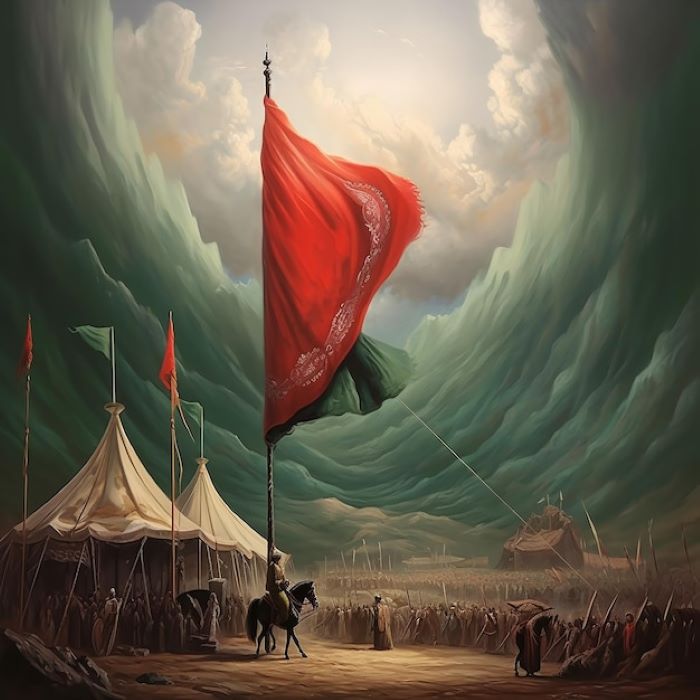
The sacrifice of Imam Hussain is a symbol of the eternal struggle against oppression and tyranny. His message has touched the hearts of millions who believe in humanity and its greater good.
Also Read more from this Author: Iran, the story untold
Curated by Humra Kidwai
Articles written by contributors have different viewpoints. The views expressed in the articles are the author’s own and not necessarily supported by TIO, The India Observer its affiliates, staff, or the management. Our Articles can be reproduced, with the following conditions, (1) No alteration to the content, (2) Visible, and full credit is given to the Author & Editor. (3) Citing, The India Observer, TIO. In the case of online or electronic media, a link to the original article must be given. Rules are strictly enforced. Any questions, email the Editor at: Mediaiss@gmail.com Or TheIndiaObserver@gmail.com

